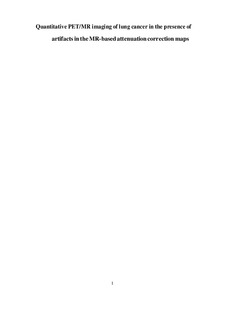| dc.description.abstract | Background
Positron emission tomography (PET)/magnetic resonance (MR) imaging may become increasingly important for assessing tumor therapy response. A prerequisite for quantitative PET/MR imaging is reliable and repeatable MR-based attenuation correction (AC).
Purpose
To investigate the frequency and test–retest reproducibility of artifacts in MR-AC maps in a lung cancer patient cohort and to study the impact of artifact corrections on PET-based tumor quantification.
Material and Methods
Twenty-five lung cancer patients underwent single-day, test–retest, 18F-fluorodeoxyglucose (FDG) PET/MR imaging. The acquired MR-AC maps were inspected for truncation, susceptibility, and tissue inversion artifacts. An anatomy-based bone template and a PET-based estimation of truncated arms were employed, while susceptibility artifacts were corrected manually. We report the frequencies of artifacts and the relative difference (RD) on standardized uptake value (SUV) based quantification in PET images reconstructed with the corrected AC maps.
Results
Truncation artifacts were found in all 50 acquisitions (100%), while susceptibility and tissue inversion artifacts were observed in six (12%) and 26 (52%) of the scans, respectively. The RD in lung tumor SUV was < 5% from bone and truncation corrections, while up to 20% RD was introduced after susceptibility artifact correction, with large inconsistencies between test–retest scans.
Conclusion
The absence of bone and truncation artifacts have limited effect on the PET quantification of lung lesions. In contrast, susceptibility artifacts caused significant and inconsistent underestimations of the lung tumor SUVs, between test–retest scans. This may have clinical implications for patients undergoing serial imaging for tumor therapy response assessment. | nb_NO |
